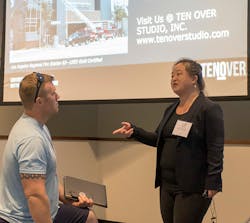FORT WORTH, TX—When designing a new station, fire officials and architects need to determine if Green or Leadership in Energy and Environmental Excellence (LEED) features will benefit their projects in the long term.
In her 2017 Station Designs Conference session, “10 Years Later: LEED Certified and Green Fire Stations,” Candice Wong, an LEED-certified architect with Ten Over Studios, said fire officials need to determine if the projects are right for them.
“LEED features are worth integrating into the new station, but only if you do them right,” Wong said.
During her tenure of designing fire stations, Wong said she is often asked if the motivation for adding LEED features is to try and establish points or win plaques for recognition.
“LEED shouldn’t be the driver, sustainable design should be driver and making smart green choices by helping you in the end,” she said.
What is LEED?
LEED started 15 years ago as a means to measure savings with the efficient use of energy and water systems, reducing carbon dioxide emissions and decreasing the toll on the surrounding environment.
“It took them some time to figure out how to standardize things,” Wong said of the LEED rating process. “Each revision creates safer and greener products.”
There are four rating systems, with three that can be applied to new fire stations: Building Design and Construction, Interior Design and Construction and Building Operations and Maintenance.
Choosing the materials to build the station also help with the LEED rating.
Wong said that masonry and brick components create sustainability because locally sourced items cut down on emissions due to the short shipping distances. Recycled content is also suggested, including rubber or concrete floors and wall panels that are all being used in their second life.
The initial planning stages
Wong cautioned that LEED ideas need to be discussed early on before finding out that the ideas can create costly additions to the project.
“A lot of times you get caught in up in green code or LEED and you forget about the actual needs,” she said. “You need to pick efficient systems that will work with your systems and you needs.”
Wong said the most common LEED features she has seen are those materials that can be “buried in the walls and in the floors” of the building envelope.
“Low-maintenance, durable materials like polished concrete or adding extra insulation into exterior walls and roofs or selecting roofs that last for well over 30 years with a thicker membrane are most common,” she noted. “Your building envelope does so much work and when it does you don’t have to cool the building as much.”
The return on investment time varies from five to 10 years, but can last as long as 30 years, Wong said.
“I think its sustainable design and making wise choices while keeping your eyes on the long-term gain, not the short-term game,” she stated.
Choosing technology that is easy to maintain
When selecting the best systems for your station, Wong suggested systems that are easy to maintain and operate. She was shocked by the feedback she received from some firefighters who said they’ve never been trained in how to use the building’s systems.
“Training is for everyone, not just the building personnel, but for the fire personnel too,” she said.
“You basically want to choose things that are easy to maintain,” Wong said, noting that stations without around-the-clock staffing might not be able to meet the daily upkeep needs and reduce the efficiency of the system.
Wong said she’s aware of projects that seem like a good fit at the time, but later found out that one component was a challenge to access or maintain and that when the technology becomes ignored it either turns into money wasted, or provides poor performance.
Case studies provide insight
To better understand the impact of design features, Ten Over Studio conducted cases studies of various stations and found that energy consumption has many variables. Two similar stations in California used surprisingly different levels of electric, gas and water.
One station—located in Death Valley—used their air conditioning a lot more than the other located in a more urban area where shade provided relief. In another example, crews in another station used less electricity then a similar station because they rarely turned the lights on due to an abundance of natural light.
Wrapping up the program, Wong asked attendees: “Does green design work? Does LEED work? I think the answer is yes, no, maybe. It depends on how you design it and how well you maintain it…you should look at the strategies that are best for your facility in your area.”







